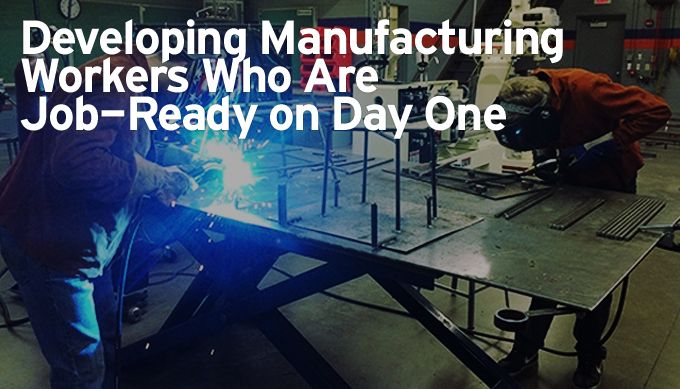Over the next decade, 3.4 million manufacturing jobs will likely be needed, and 60% of them are likely to be unfilled due to the talent shortage. How can we close that number (and the skills gap)?
Bob Graff | Yaskawa
Reprinted with permission from IndustryWeek:
During the State of the Union address earlier this year, President Obama said America should be “offering every student the hands-on computer science and math classes that make them job-ready on day one.” The president has likely heard what many manufacturing companies say: We need students prepared with the certifications and skills to be productive upon graduation.
Engaging policy makers is part of the challenge. But another piece is industry’s focus on helping to shape STEM curriculum to meet the growing demand for technical careers in automation. In this way, educators are working toward creating STEM degrees and certification programs to meet the rising need for skilled manufacturing jobs. And the need is great. According to a study by Deloitte and the Manufacturing Institute, “over the next decade, 3.4 million manufacturing jobs will likely be needed. 60% of these positions are likely to be unfilled due to the talent shortage.”
Hands-On Training
STEM is defined by what schools are teaching (or focused on) in their curriculum, which might include STEM robotics kits, PLC programming, CNC programming, virtualization and modeling. The classes offered by high schools, vocational schools and other educational institutions combine technology and curriculum that have been traditionally focused on academics versus a career in industry. The trend is to provide an industrial automation experience that is both hands-on and relevant to the industries that are using this technology.
One challenge for education and industry is creating the right curriculum, tools and services to support career paths. Another challenge is taking new curriculum and making it sustainable for years to come.
Approximately 75% of public schools have some sort of STEM-related programs for students. The fact is that most people hired now in industrial robotics jobs have been exposed to some degree of STEM instruction or hold a robotics-related certification, but their skills are not mirroring industry requirements.
The misunderstanding stems from the fact that most departments of education are very sensitive about supporting a specific robot brand or industry-specific technology and curriculum. The good news is that some educators are currently assessing how to align and blend specific manufacturers’ industrial curriculum into state-wide approved degree or certification programs that support career paths. And workforce development is changing the face of the traditional education model (i.e., academic-based degree) to a skills-based degree supported by industry. This is a win-win situation for industry, education and the economy.
In the case of robotics, education must depend on robot manufacturers and the industries that use robots to determine what specific skills (e.g., programming, maintenance, troubleshooting, etc.) need to be taught and certified.
Repurposing a Successful Concept
Approximately 20 years ago, Cisco launched an educational initiative to support building its networks. Cisco realized it wasn’t enough to install networks. Somebody had to maintain them once they were running. A Phoenix-based Cisco engineer named George Ward founded what would become the Cisco Networking Academy to offer educational institutions a way to help high school and college students learn to design, build and run computer networks. Because schools adopted the Cisco curriculum the employers soon had graduates who could immediately step into networking jobs.
Similarly, education and industry need to work together today to identify the skills that workers will need on the job. Identifying the skills gaps will help to define the curriculum, certification and work requirements necessary for students to be hired. With the skills gap clearly defined, the workforce development partnership creates an educational path to fill real jobs year after year. This allows the educational organizations to define cost, resources and a model to support the skills required within the industry. The major benefit of industry and education working together is that they can grow the economy, funding and management of a robotic degree program — including facility, equipment, certification and marketing — that is sustainable.
In Indiana, for example, there are a number of advance automation companies that have a need for skilled robotics workers. These companies are partnering with local school districts. As part of the initiative, the Vigo County School Corporation partnered with Yaskawa Motoman to define a model to teach robotics at one of the county’s high schools. The aim was to replicate the curriculum statewide through the support of the state’s department of education.
By researching the school district and department’s academic needs, robotics manufacturers can deliver content that educators can use to teach job skills that industrial partners need, such as programming, troubleshooting, data analytics, pick and place, and basic welding.
Three years ago, Charles Speelman, superintendent of Tri-Rivers Career Center in Marion, Ohio, was receiving calls from local companies saying that there weren’t enough skilled workers entering the trades, especially manufacturing. This led Tri-Rivers Career Center (with an approximately $15 million grant from Ohio) to launch the Robotics & Advanced Manufacturing Technology Education Collaborative, known as RAMTEC.
When Speelman came to Yaskawa Motoman for help with a robotics curriculum, we jumped at the chance to develop a template. We developed a robotics curriculum that offered industry-level instruction and certifications for undergraduates, as well as students headed to vocational schools. Educators like Speelman ask companies where the gaps lie. In response, they talk about teaching students pragmatically and with the same machines they’ll encounter in the workforce. Once RAMTEC students complete the robotics curriculum, and are skilled in troubleshooting, maintenance, modeling, and virtualization, they can be job-ready on day one.
Getting workers ready in this way will reverse some long-standing trends. For instance,The Wall Street Journal reported that apprenticeship programs that mix on-the-job learning with mentorships and classroom training fell by 40% in the U.S. from 2003 to 2014. As industry looks at its skills gaps, managers owe it to themselves and their future workforce to reach out to neighboring schools and policy makers to explain in detail what’s needed. Many of these partnerships already exist or could be shaped if industrial leaders begin the dialogue. There are pools of talent everywhere. Among the best to draw from may be those closest to the point of need. But to fully implement a successful career-path model for workforce development, educators and industry must cooperate, collaborate and develop the curriculum students need. As part of that education, industry must also show students the many aspects of engineering and combat the misguided notion that all manufacturing jobs are low-tech and dangerous. A key to success is creating a workforce development model that is both sustainable and designed for growth.
About Bob Graff
Bob Graff is senior director for Robotics Education and Workforce Development at Yaskawa America Inc. — Motoman Robotics Division. Graff has spent more than 30 years serving the education-technology industry in management, sales, product development, training and consulting. You can reach him at Bob.Graff@motoman.com.
The content & opinions in this article are the author’s and do not necessarily represent the views of ManufacturingTomorrow
Comments (0)
This post does not have any comments. Be the first to leave a comment below.
Featured Product


